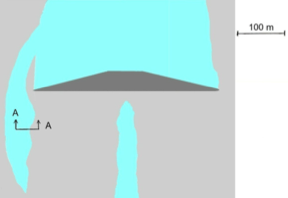ASIA 2014 – Session 7
by François Lempérière
The need in Asia of water storage for irrigation and drinking waters is as important in flat areas as in steep areas. The relevant design criteria may be very different. Examples are suggested below for a typical storage of 1 hm3 with a dam height under 10 m, i.e. with an average reservoir depth of 2 or 3 m, a reservoir area of 0,3 or 0,5 km². The banks slope is few % and the dam length in the range of 1 000 m. The catchment area may be 5 to 20 km². Most flow is within few months and the discharge over 5 m3/s limited to some dozens hours per year. The yearly flood may be 10 or 20 m3/s, the flood of yearly probability 1/100 or 1/1 000 about 100 m3/s. In many places, especially in Asia, monthly evaporation may be 10 to 20 cm.
Design criteria
The acceptable probability of failure should be linked with the impacts of a failure. It may be 10-3 where the flow from a breach is not much more than the incoming flow: this may be the case for a well compacted material including clay and especially if the breach is where the dam height is under 3 or 4 m. The key point is that usual designs applying to dams over 15 m high may be totally unadapted to dams lower than 10 m:
- The best places for dams in steep areas may be narrow sites: in rather flat areas the best places for storage may be rather flat places.
- Most dams lay-outs are straight. It may be wrong for low long dams.
- A traditional design for spillways is a rather short concrete spillway, usually ungated for such storage, as example 20 or 30 m long with a sill 2 m under the embankment crest. It has three drawbacks:
– The cost is high.
– The loss of storage due to freeboard may be over 30%, especially will huge evaporation.
– Half of failures by internal erosion are between a rigid structure and an embankment.
Alternative 1 – Overtopping of embankment
Spillage is a nappe depth of 0,2 or 0,3 m, i.e. under 0,5 m3/s/m along about 200 m where the dam height is under 2 m and where the downstream slope may be 5/1 with some protection by grass or cemented material. The central part of the dam may be only 0,50 m over the reservoir level and have a parapet for waves. Floods under few m3/s may be discharged by a pipe. This solution reduces the cost and/or increases the storage. In Case of failure, the breach is limited and easily repaired. This solution applies to materials including clay and not to the sandy materials. 
Lay-out
Alternative 2 – Side channel and downstream spillway
Excavating a wide channel in a flat bank and discharging floods on natural flat ground few hundreds m downstream of the dam may be cost effective. The channel excavation, limiting water speed to 1 m or 1,5 m/s, will be dozens of thousands m3, but at low unit cost, and possibly used for the dam fill. Lining may be by grass. A small concrete beam (0,5 x 0,5 m) will spread equally the flow. 
Lay-out

Cross section AA
Alternative 3 – Diverting floods
Some reservoirs store only 20% of the yearly flow but store most of sediments and the useful storage may be much reduced after 10 or 20 years. It may be possible to associate the previous alternative with a small dyke along a flat bank within the reservoir. Such dyke may use the channel excavation; it is not costly and its possible failure would have little impact and little repair cost. Siltation of the reservoir is much reduced. 
Lay-out
Alternative 4 – Side reservoir
The average reservoir depth is 2 or 3 m and a part is lost by evaporation. In flat areas it may be better to create a side reservoir with an average 8 m depth. The volume of the relevant dyke will be higher but the unit cost rather low and there are no more problems of siltation or spillway. For 1 hm3, a 200 kW pump used few hundreds hours per year with an average flow of 0,5 m3/s is not expensive and the yearly cost of fuel or electric power appears acceptable (20 000 kWh/year).
Alternative 5 – Concrete or masonry dam
In rock areas it may be possible to place concrete or masonry on natural rock, even of poor quality, with a cross section adapted to overtopping. Spilling may be all along the dam. This may be adapted to discharges up to 1 000 m3/s, i.e. to rather large catchment areas and to storage well over 1 hm3. It seems more cost effective than a short central spillway. 

Alternative 6 – P.K. Weirs
If the choice of a traditional concrete spillway is kept, it is possible and cost effective to increase the storage and/or reduce the cost using a simplified P.K. Weir labyrinth with vertical walls such as per drawing. With walls 2 m high, the nappe depth for a same flow is reduced by 0,75 or 1 m, which may increase the storage or reduce the dam volume by 20 or 30%. Designs could be standardized within a country. 
P.K. Weir lay-out

BB

AA
Overall study in a country
A country may have hundreds or thousands possible sites for such reservoirs. It may be easy to have cost comparizons of alternatives with traditional designs, to build accordingly some dams with new designs. It is possible to test the spillage along a small part of the spillway with an ordinary flood. Most solutions may be adapted to a future raising of the dam.
Existing dams
Most alternatives above may apply to many existing dams for improving safety or increasing storage.